
Prevent Cross-Site Tracking on Poco F5 5G and Browser | Dr.fone

Prevent Cross-Site Tracking on Poco F5 5G and Browser
Have you ever wondered why you get the advertisements of the websites you visited a few minutes ago on your social media sites? Here comes to Cross-Site Tracking, also termed CST, and it is a process where third-party cookies and sites track your browser history.
![]()
The CST process is like invading your privacy by collecting your browser history and personal information. So, to prevent these services, there are several ways by which you can cross-site tracking on your system as well as Poco F5 5G phone browsers. Keep reading to learn how to stop cross-site tracking on both Poco F5 5G and browser.
Part 1: Why Do We Need to Stop Cross-site Tracking?
Cross-site Tracking is all about collecting your browsing data and other information for advertising purposes. Though the process can prove convenient for many as it provides additional information about the products and services you have searched for and offers tailor-made content, it is intrusive and about breaching your privacy.
Cross-site tracking collects information about your browsing history. The third-party cookies also monitor the content type you have visited and your personal information, which is risky.
Besides invading privacy, the CST also poses several other issues. Based on your browsing history, additional content you have not asked for is loaded on your visited sites, slows down the page loading process, and puts an extra burden on your battery. Moreover, too much-unwanted content can interfere with the basic information you are looking for.
So, it is always better to prevent cross-site tracking for all the above and more reasons.
Further reading: A detailed guide on faking location in Mozilla Firefox . Don’t worry about your location privacy anymore!
Part 2: Can Private Browsing be traced?
Yes, private browsing can be traced. When you work in private browsing mode, the web browser does not save the browsing history, which means that anyone who uses your system will not check your online activities. But websites and cookies can track your browsing history as well as other information.
Part 3: How to Disable Cross-website Tracking on Safari for iOS Devices?
Safari is the most commonly used platform by iOS users. So, to prevent CST for Safari on your iOS devices and Mac systems, below is a complete guide.
Deactivate Safari cross-website tracking for iPhone & iPad
Safari cross-site tracking can be prevented using the below steps on your iPhone and iPad.
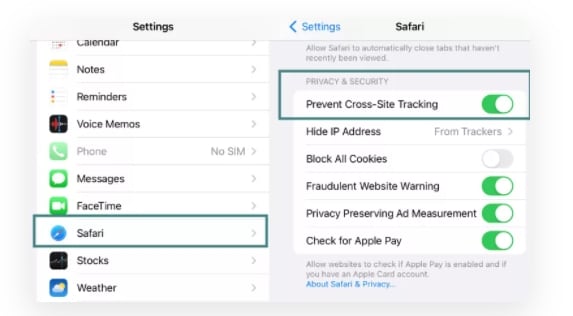
- Step 1. Launch the Settings app on your iOS device.
- Step 2. Find the Safari option by scrolling down the menu.
- Step 3. Move the slider to turn on “Prevent Cross-Site Tracking” under the PRIVACY & SECURITY option.
Deactivate Safari cross-website tracking for Mac
Use the steps below to turn off cross-site tracking on Safari on your Mac systems.
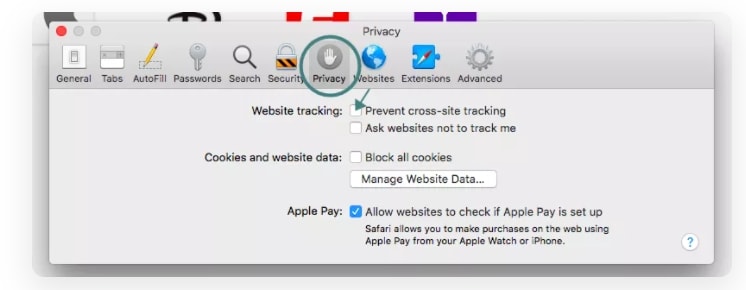
- Step 1. On your Mac system, open the Safari app.
- Step 2. Move to Safari > Preferences > Privacy
- Step 3. Enable the “Prevent cross tracking” option by clicking on the box next to it.
Part 4: How to Disable Cross-site Tracking on Google Chrome
Chrome is used widely on Windows systems and Android devices, and to prevent the CST from your browser, a detailed guide is given below.
Enable “Do Not Track” on Google Chrome for Android
- Step 1. On your Poco F5 5G, open the Chrome app.
- Step 2. At the right side of the address bar, click on the More option and choose Settings.
- Step 3. Choose the Privacy option from the Advanced tab.
- Step 4. Click on the “Do Not Track” option to turn on the feature.

Enable “Do Not Track” on Google Chrome for Computer
- Step 1. Launch Chrome on your system, and from the menu at the upper-right corner, click on the Settings option.
- Step 2. From the “Privacy and Security” tab, choose the “Cookies and other site data” option.
- Step 3. Tap and enable the slider next to “Send a “Do not track” request with your browsing traffic.”

Part 5: Recommended Solution: Fake a Location to Stop Cross-Site Location Tracking Using Dr. Fone
What if you let the sites and cookies track your phone location without worrying about your privacy? Yes, it can be done by spoofing your location. So, if you set a fake location while browsing the internet, you will not have to worry about cross-site tracking, as anyways, the sites and cookies will get misled browsing information that cannot harm you in any manner.
Setting a fake location on your iOS devices, a professional tool is needed, for we recommend Wondershare Dr.Fone - Virtual Location as the best tool. Using this Android and iOS-based software, you can set any fake GPS location on your device. The tool is simple to use and does not require any mastery of technical know-how.
Key features
- Simple tool to teleport to any GPS location in a single click.
- Allows simulating GPS movement along the route.
- All popular models of Android and iOS devices are compatible.
- Compatible with all location-based apps on your phone.
- Compatible with Windows and Mac systems.
Here is a video tutorial for you to take an overview of how to use Dr.Fone - Virtual Location to fake location on your Android and iOS devices.

Steps to set fake location on your Android and iOS devices using DrFone-Virtual Location
Step 1. Download, install and launch the software on your Windows or Mac systems. On the main software interface, choose the Virtual Location option.

Step 2. Connect your iPhone or Android device to your system using a USB cable and then tap on the Get Started option on your software interface.
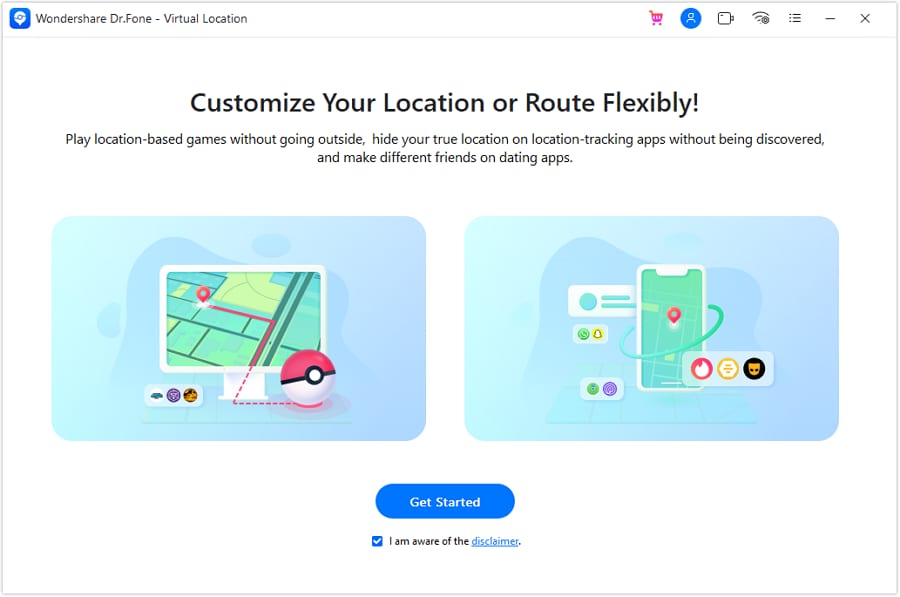
Step 3. A new window on the software interface will open, showing your connected phone’s real and actual location. If the detected location is incorrect, click on the “Center On” icon to display the right device location.
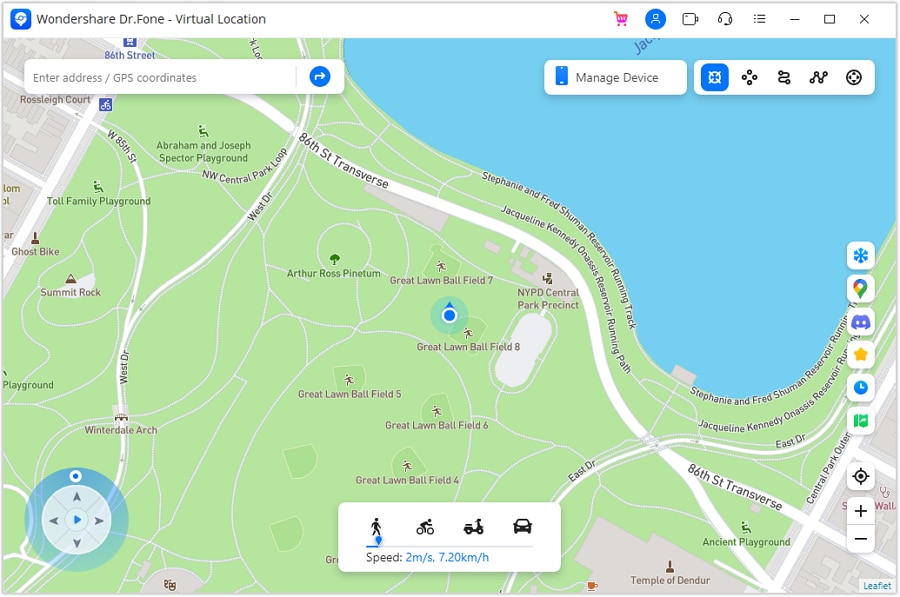
Step 4. Next, you need to activate the “teleport mode” and click o the 3rd icon at the upper-right corner.
Step 5. Next, you have to enter now the fake location to which you wish to teleport to at the upper-left corner. Click on Go.

Step 6. Finally, tap on the Move Here button and the new fake location for your connected Android or iOS device at the pop-up box.
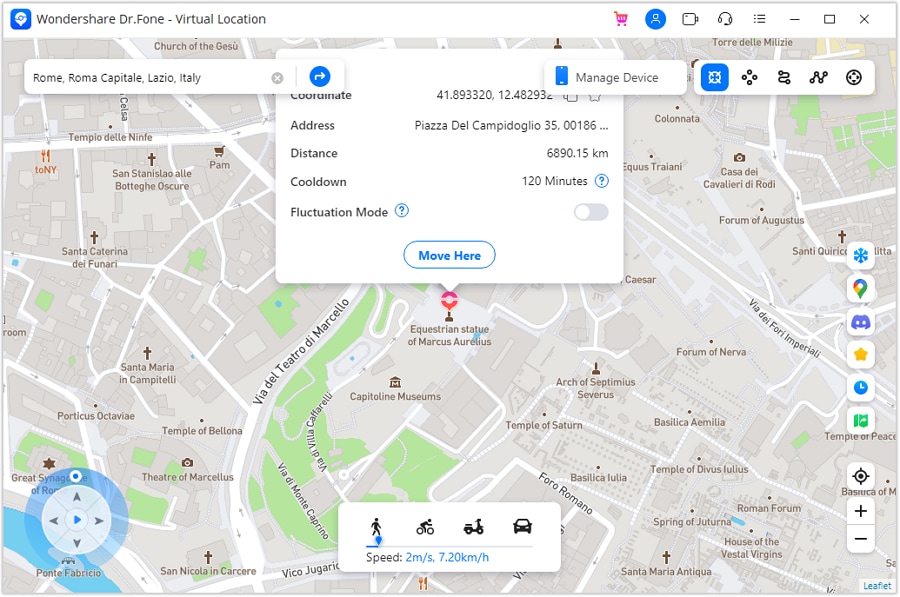
Check the new location of your phone from the app.

Wrap it up
Preventing Cross-site tracking can be done on different browsers and devices using the guides listed in the above parts of the article. Settings a fake location for your device using Dr. Fone-Virtual Location is another interesting way to prevent tracking your browsing history by spoofing the sites and cookies. Setting a fake place will not only avoid monitoring your browsing history but will also work with all location-based apps on your phone.

How to Stop Google Chrome from Tracking Your Location On Poco F5 5G?
Do you know your web browser is continually sharing your actual location online? You might not have noticed, but the number of websites using your location has increased. As you are well aware of the dangers of the internet, it doesn’t make sense to turn your Chrome into a beacon for ill-intentioned people. Luckily, it is possible to fake a location on Chrome with the right tool.
Are you wondering how to fake the browser location or which tool to use? You can get all your answers by reading this article till the end.

Part 1: How Does Chrome Know Your Location?
Before discussing Google Chrome’s fake location, it is important to know how Chrome detects your physical location. Google Chrome uses many ways to pinpoint your exact location, like your IP address, GPS, Wi-Fi, Bluetooth, and Cell Tower data. Every internet connection has an IP address bound to a location that enables Chrome to identify your location.
Similarly, GPS location can easily be tracked if your phone device has it enabled. All the Wi-Fi and Bluetooth connections around you also have location information embedded in them. They can help Chrome track you as long as your device can detect them. If you use cell data, Google Chrome can also track you through cell towers.
Part 2: How to Hide Location Services in Chrome?
If you are worried about Google Chrome detecting your physical location and sharing it with websites and apps, you can hide it easily. The process of hiding your location on Google Chrome is simple, even if you are using multiple devices. Below is the step-by-step process of hiding location services in Google Chrome on computer, Android, and iOS devices.
Method 1: For Laptop and Desktop PCs
Step 1: Launch Google Chrome on your computer and click the “Three Dots” icon to open the Google Chrome Settings. Here, tap “Privacy and Security” from the left sidebar and select “Site Settings.”
company, user or members of the same household. Action! - screen and game recorder</a>

Step 2: Navigate to “Permissions” and click on “Location.” To hide the location on Google Chrome, select the “Don’t allow sites to see your location” option.

Method 2: For iPhone or iPad
Step 1: Navigate to “Settings” on your iPhone and open it. Scroll down until you find the “Chrome” app option and select it.

Step 2: Press “Location” on the next screen to open the location options for Google Chrome. Here, choose “Never” to stop Google Chrome from detecting your location.

Method 3: For Android
Step 1: Open Google Chrome on your Poco F5 5G, press the “Three-Dots” icon, and tap “Settings” from the options.

Step 2: In Chrome Settings, press “Site Settings.” Now select “Location” and hide your location by toggling off the “Location” option.

One way to protect your privacy and stop websites from tracking your location is to turn off the location, but it has many disadvantages. If you have turned off your location, you can’t use any location base service like food delivery, e-shopping, ride-sharing, etc. That’s why it is better to use a fake location on your browser. Below we have explained four methods for Chrome fake location.
 HD Video Converter Factory Pro
HD Video Converter Factory Pro
Method 1. Best Tool to Fake Chrome Location On iOS and Android Phones
The easiest and quickest way to fake your location on Google Chrome is to use Dr.Fone - Virtual Location . Since smartphones contain a wide range of apps that require location access, it provides a stable way to fake Chrome locations on Android and iOS phones. No website or app will be able to detect that you are using a fake location when using Dr.Fone - Virtual Location for faking GPS location.
Key Features
- Dr.Fone - Virtual Location can be used for any social media app like Facebook, Twitter, or Instagram with a fake location.
- With the help of this tool, you can also spoof real-time tracking apps like Life360 to protect your privacy.
- If you are an iPhone user, you don’t have to jailbreak your iPhone to spoof your device’s location.
How to Fake Chrome Location On iOS/Android Phones via Dr.Fone - Virtual Location
Faking your Chrome location with Dr.Fone - Virtual Location is very straightforward. You only need the Dr.Fone mobile toolkit and a USB cable to connect your Poco F5 5G. Follow these steps to spoof Chrome location on Android and iOS phones:
Step 1: Connect Your Android/iOS Device to Your Computer
Connect your Android or iOS phone to your computer using a USB cable. Launch the Dr.Fone robust toolkit on your computer and select “Virtual Location.”

Step 2: Activate the Teleport Mode
Press “Get Started” on the next page to open the map window. First, select your actual location by pressing the “Center On” icon from the right sidebar. Afterward, click on the “Teleport” icon from the top right corner to activate the Teleport Mode.
Step 3: Add the Desired Fake Location
Once the Teleport Mode is activated, add your desired location and press “Go.” Your desired location will open on the map. Select it, and a pop-up window will appear where you need to press “Move Here.” With that, your Android or iPhone’s Chrome location has been changed.

Method 2. Manually Change Your Location Using Google Chrome DevTools
It is also possible to fake browser location on Chrome using the Google Chrome Developer Tools. It is a built-in feature of Chrome and can be used to manually change or turn off your browser’s location. Follow these steps for changing location on Chrome with DevTools:
Step 1: After opening Google Chrome, click the three-dots icon from the top right corner. It will open the Chrome menu where you need to select “Developer Tools” after clicking “More Tools.”
 Power Tools add-on for Google Sheets, Lifetime subscription
Power Tools add-on for Google Sheets, Lifetime subscription

Step 2: A window will open on the right side with all the developing tools you can use in Chrome. Click on the three-dots icon located near “Console” in the bottom left corner of the window. Choose “Sensors” from the pop-up menu.

Step 3: Access the newly selected “Sensor” option, and here you can change the browser’s location by either selecting a Google’s pre-set location or adding your desired location manually. Once the location is selected or added, your browser’s location will change.

Limitations
- The interface of the Google Chrome DevTools can be very confusing and overwhelming for non-technical users.
- Apart from pre-added locations, it can be hard to add a specific location as your fake location.
 SwifDoo PDF Perpetual (2-PC) Free upgrade. No monthly fees ever.
SwifDoo PDF Perpetual (2-PC) Free upgrade. No monthly fees ever.
Method 3. Fake Your Location Using Chrome Extension
Many fake location Chrome extensions are available on Google Chrome which can be used to alter your location on Chrome. You can find these extensions on Google Chrome Web Store and add them directly to your browser. Below we have explained the steps for using such an extension “Location Guard “ to fake your location on Google Chrome:
Step 1: Open the “Location Guard” on Chrome Web Store and click “Add to Chrome” to add it to your browser. Once the “Location Guard” extension is added, open it and press “Options.”

Step 2: In the options, you can choose different options like Privacy Levels, Protection Area, and Time for Location Cache. It is recommended you choose a higher level for more protection.
 Glarysoft File Recovery Pro - Helps to recover your lost file/data, even permanently deleted data.
Glarysoft File Recovery Pro - Helps to recover your lost file/data, even permanently deleted data.

Step 3: You can also use the “Fixed Location” feature to set up a fake location as a permanent location for your browser. The fixed location can be added by using the market or clicking on the desired place on the map.

Limitations
- Location Guard doesn’t protect your IP address. It means some websites can still detect your real location using the IP address.
- The app is not updated for quite a while, that’s why the map of the fixed location feature is quite restricted.
Method 4. Spoof Your IP Using a VPN Server
Another way you can fool websites and your browser by displaying a fake location online is to use a VPN server. VPNs fake your IP address to fool websites and apps into detecting your location. NordVPN is a VPN that can be used to spoof your IP by following these steps:
Step 1: Download and install NordVPN on your computer or phone and log in using your account. If you don’t have a NordVPN account, you must create one first.
Step 2: If you want to just change the location of your device, you can select “Quick Connect.” Using it will enable the program to automatically find the most suited fake location for you.

Step 3: You can also choose the desired location as your fake Chrome location in NordVPN. To do that, scroll down the list of countries and locations and choose your desired locations to connect to.
Limitations
- NordVPN can only spoof your IP address and will not work for geo-restricted applications.
- Using a VPN usually affects your internet speed and can make browsing slower and more difficult.
Part 4: FAQs
1.What is Geolocation?
Geolocation is a term used for the process of pinpointing the location of a device connected to the internet. The location can be determined using methods like IP address, GPS, and mobile tower data. Apps and websites commonly use it to provide location-based services.
2.What is the HTML5 Geolocation API?
The HTML5 Geolocation API is a browser API used to determine a user’s geographical location. Developers use it to build location-aware websites and apps that use users’ locations as the basis for providing their services. It can detect location through GPS, Wi-Fi, Bluetooth, IP addresses, etc.
3.Why should you hide or spoof your Location?
Hiding or spoofing your location protects your privacy and stop application and websites from tracking you. It also allows you to access geo-restricted apps and play location-based games. You can also fake your location to get the latest updates of your favorite apps.
Conclusion
The fact that Google Chrome in your devices can track your location with an accuracy of up to 20 meters is very unsettling for users. Even when you try to be careful in granting location permissions to apps and websites, many can still bypass this by adding location access requirements in terms and conditions.
That’s why having a tool like Dr.Fone - Virtual Location to fake GPS online is essential nowadays. It can ensure your privacy and helps in protecting you from the dangers of the internet.
Life360: Learn How Everything Works On Poco F5 5G
Nothing is more important than your mobile device when it comes to your security, privacy, and family. Thanks to its easy-to-use features and excellent app, with Life360, your life will be as secure and private as possible.
Whether you’re looking to sync photos, videos, contacts, messages, and locations with your mobile devices and computers or simply set up your home cameras to automatically send you alerts, Life360 is designed to be the most powerful mobile phone service provider you’ve ever seen.
It’s the most secure and easiest-to-use service, but it’s not the cheapest. So, let’s know what Life360 is and how Life360 work.
Part 1: What Is Life360?
A smartphone software called Life360 tracking system enables families to communicate, track their whereabouts, and get alerts about their loved one’s safety and well-being.
When Life360 is installed on the phone, the administrator may create geo-fences specifying certain locations. For example, geo-fences might be employed to monitor family members’ arrival and departure times. In addition to that, the program provides driving analysis by means of the Life360 Driver Protect module.
Additionally, BMW has incorporated Life360 into its onboard location tracking. Accident identification and rescue operations are provided through an app that tracks authorized drivers and offers monitoring and analysis.
Both parties need to have the app installed for one to be able to monitor the activities of the other. Using the app, you can see where your phone is at any given moment. A member of your family might know exactly where you are at any given time if they have the app on their phone.
Whether you are currently using the app or not, the Life360 app tracker will always be able to pinpoint the exact location of your mobile device. In addition, you may obtain real-time location information on each other, view it on a hidden map, and even choose to get automatic notifications anytime someone enters or departs a spot, according to the Life 360 website.
Every time a family member departs or comes someplace, an alert is sent to the rest of the family. You can share your location with an adult, and they can see how fast you were driving, how long it took you to come home, and who was home or at school while you were gone.
In addition, adults and children may obtain real-time instructions from a particular family member. For example, you may touch an icon of a family member to receive instructions to that user’s location on the Life360 website.
Part 3: Is Life360 Always Accurate?
Previously, Life360 was criticized for being inaccurate, especially when locating people. However, the company has recently updated its system to ensure that the data it collects is accurate.
The Life360 app uses GPS technology to track your location. When you first install the app, you will be prompted to set up your location. This is done by entering your zip code, city, and state.
You will also be asked to select a default location. This will be used to determine your home address. Once you enter your zip code, city, and state, you will be able to view your location on a map.
Also, Life360 works best in urban areas. If you live in an area with many tall buildings, Life360 may not work as well.
## Part 4: Is Life360 Safe for Your Privacy?Life360 is a relatively new app, but it has been getting attention lately. People are wondering whether it is safe for them to use and whether or not it is worth it.
According to the Life360 website, the app is safe because it is encrypted. The encryption ensures that no one can intercept your communications.
If you are worried about privacy, you can disable the app’s location tracking feature. You can also disable the feature if you want to be notified whenever someone enters or leaves a particular area.
You can also use the app without giving anyone else access to your location. You can create a guest profile.
There are no ads or in-app purchases. You do not have to give any information to Life360. You can use the app without giving any information.
Life360 is also very easy to use. You do not need to have any special training to use the app. You simply need to sign up and download the app.
Life360 is available for free on Google Play and Apple App Store.
Part 5: Can a Location be faked on Life360?
What if You do not want your location to be tracked by someone else? One of the main reasons why people use Life360 is that it allows you to share your location with friends, family, and even strangers. However, if you do not want to be tracked by others, you need to know how to fake your location.
Unfortunately, you cannot spoof your location through Life360, so it is evident that you have to use another way to ensure that no one will know where you are. The easiest solution is an application called Dr.Fone - Virtual Location which can help you change your location in real-time.
Dr.Fone - Virtual Location is a comprehensive data management desktop software, which helps you to get all your data in one place and protect your important files from being lost. The software is easy to use and compatible with all Android and iOS devices.
You can also remotely wipe sensitive data and settings from any device at any time. With this software, you can backup your contacts, messages, photos, videos, call history, etc., to your PC or to the cloud service. All these features come as part of this.
Setting a virtual location is one of the prime role Dr.Fone plays.
Dr.Fone - Virtual Location
1-Click Location Changer for both iOS and Android
- Teleport from one location to another across the world from the comfort of your home.
- With just a few selections on your computer, you can make members of your circle believe you’re anywhere you want.
- Stimulate and imitate movement and set the speed and stops you take along the way.
- Compatible with both iOS and Android systems.
- Work with location-based apps, like Pokemon Go , Snapchat , Instagram , Facebook , etc.
3981454 people have downloaded it
Steps To Fake Your Location with Dr.Fone Virtual Location
Downloading Dr.Fone - Virtual Location (for iOS or Android) is the first thing that has to be taken. After that, run the executable file to begin using the application.

Step 1: After going through all of the available choices, choose “Virtual Location,” and then connect your iPhone or Android phone to your computer. Select “Get Started” from the drop-down menu.

For iPhone users, after the program has been linked via a USB cord, it is possible to connect wirelessly without a connection.

Step 2: You may see your current position on a map in the new window. If you are having trouble finding your current position when looking for locations on the map, you may hit the “center on” symbol that is located in the side to the right of the map to reveal your exact location.
Step 3: Tap the matching icon in the top right to enter “teleport mode.” It’s as simple as entering your destination location in the top left corner and clicking on the “go” button. Let’s look at Rome, Italy, as an illustration of this.

Step 4: It’s clear to the system that Rome is your destination. To relocate, choose “Move Here” from the menu that appears.

Step 5: Now you’re in Rome instead of wherever you were before. Your iOS or Android smartphone will always show Rome, Italy as your location, regardless of where you really are. This is the exact same location that appears in your location-based program.
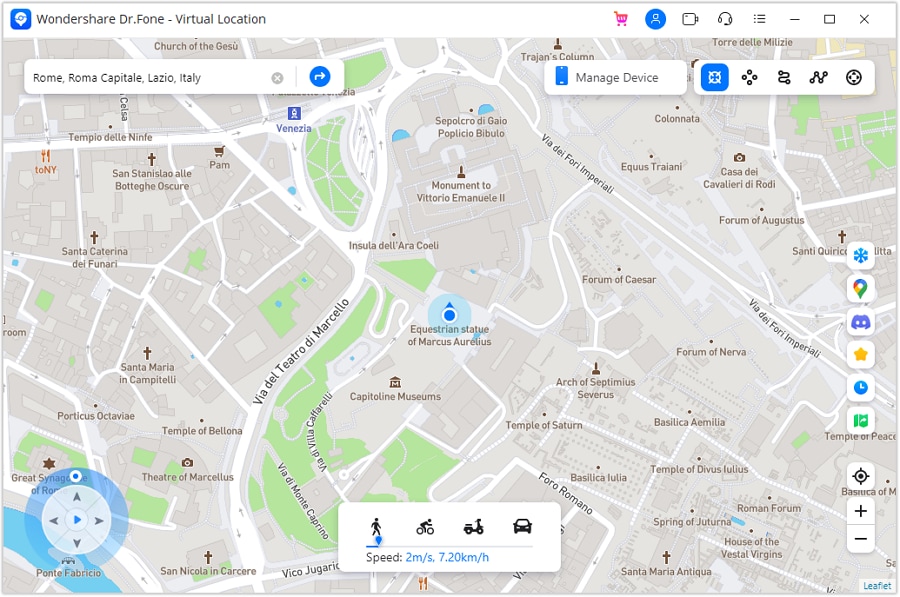
Part 6: FAQs
1. What are Life360 events?
Although Life360 events are a great way to keep your loved ones informed about your whereabouts, they also provide information about your location, like the weather, time, and date. You can even set an alert when you arrive at a specific location.
For example, if you want to see who is at your house, you can set an event to notify you when someone enters or leaves your home.
2. What does protecting a drive on Life360 do?
Improve your family’s driving habits by getting a weekly picture of everyone’s driving habits. Gain a comprehensive understanding of the driving patterns of every member of the Circle.
Find out about things like your highest speed and whether or not you text while driving, among other things. Then, take a look at individual drives to find out details such as the exact route taken, the number of kilometers recorded, the peak speed, driving style, and the locations of any driving incidents.
When Circle members are on the road, whether driving, using public transportation, or traveling with companions, keep an eye on their peak speed.
3. Why does life360 show walking instead of driving?
In brief, it is because walking is less likely to be used for commuting than driving. For example, if you live in a rural area, you may not have access to public transportation, and therefore, you would have to walk to work.
4. What does it mean when life360 doesn’t update?
It means that the Poco F5 5G device you’re using is not connected to the internet. In this case, you should check if your internet connection is working properly. If you’re sure your internet connection is working fine, try restarting your device.
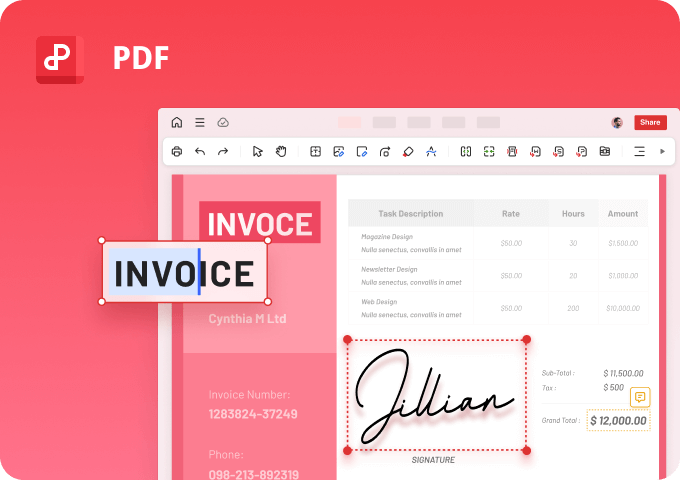
WPS Office Premium ( File Recovery, Photo Scanning, Convert PDF)–Yearly
5. Does Life360 work when your phone is off?
In the event that you switch off your phone, the GPS feature will also be disabled. As a result, it will not be able to determine your position when your phone is turned off.
However, Life360 will continue to provide the most recent location data uploaded to your account. So, a life360 login online is necessary.
Conclusion
Life360 is a useful application that helps you keep tabs on your loved ones. You can track location, receive notifications, and get alerts. But if you want to fake your location, Dr.Fone - Virtual Location is the most recommended product because of its unique features and easy-to-use interface.
- Title: Prevent Cross-Site Tracking on Poco F5 5G and Browser | Dr.fone
- Author: Ava
- Created at : 2024-08-01 20:47:27
- Updated at : 2024-08-02 20:47:27
- Link: https://fake-location.techidaily.com/prevent-cross-site-tracking-on-poco-f5-5g-and-browser-drfone-by-drfone-virtual-android/
- License: This work is licensed under CC BY-NC-SA 4.0.
 PCDJ DEX 3 for Windows & MAC is the total entertainment DJ software solution, offering audio, video, and karaoke mixing ability. Automatic beat-sync, smart looping, 4 decks, DJ MIDI controller support, Karaoke Streaming and much more.
PCDJ DEX 3 for Windows & MAC is the total entertainment DJ software solution, offering audio, video, and karaoke mixing ability. Automatic beat-sync, smart looping, 4 decks, DJ MIDI controller support, Karaoke Streaming and much more.

 vMix 4K - Software based live production. vMix 4K includes everything in vMix HD plus 4K support, PTZ control, External/Fullscreen output, 4 Virtual Outputs, 1 Replay, 4 vMix Call, and 2 Recorders.
vMix 4K - Software based live production. vMix 4K includes everything in vMix HD plus 4K support, PTZ control, External/Fullscreen output, 4 Virtual Outputs, 1 Replay, 4 vMix Call, and 2 Recorders.







 vMix Pro - Software based live production. vMix Pro includes everything in vMix 4K plus 8 channels of Replay and 8 vMix Call
vMix Pro - Software based live production. vMix Pro includes everything in vMix 4K plus 8 channels of Replay and 8 vMix Call
 Epubor Audible Converter for Win: Download and convert Audible AAXC/AA/AAX to MP3 with 100% original quality preserved.
Epubor Audible Converter for Win: Download and convert Audible AAXC/AA/AAX to MP3 with 100% original quality preserved.